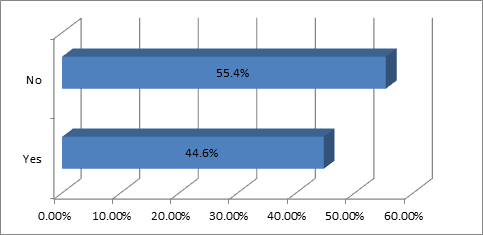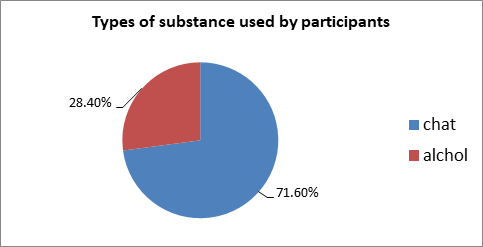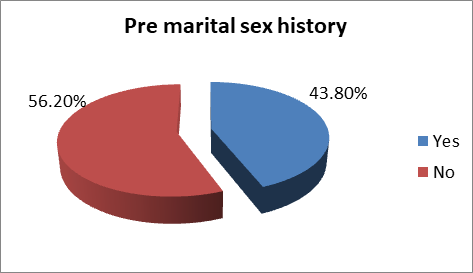eISSN: 2572-8474


Research Article Volume 7 Issue 1
1Department of Nursing, College of Medicine and Health Sciences, Mizan Tepi University, Ethiopia
2Department of Midwifery, College of Medicine and Health Science, Wachamo University, Ethiopia
Correspondence: Abiy Tadesse, MSc in Adult health nursing, Department of Nursing, Mizan Tepi University, College of Medicine and Health sciences, Mizan Aman, Ethiopia
Received: February 14, 2020 | Published: February 21, 2020
Citation: Angelo AT, Geltore TE, Dacho AM. Assessment of pre-marital sex and its associated factors among rift valley university college students, jimma campus, south west Ethiopia, 2018. Nurse Care Open Acces J. 2020;7(1):27-33. DOI: 10.15406/ncoaj.2020.07.00213
Introduction: The World Health Organization (WHO) defines adolescent people as those between the ages of 10 to 19 years. By nature these age groups are the age of experimentation and exploration associated with a range of risky behaviors, including risky sexual behaviors. Pre-marital sex as risky sexual practices can lead student adolescents to acquisition of STIs and un-intended pregnancy. However there is paucity of information in prevalence of pre-marital sexual practices and it factors in private higher institutions particularly to the study site. Therefore this study is aimed to assess the prevalence of pre-marital sex practices and associated factors among Rift valley university students, south western Ethiopia 2018.
Methods: An institution based cross sectional study was conducted at Rift Valley University Jimma campus from March to April 2018. A pretested structured questionnaire was used to collect the data. Systematic random sampling technique was employed to select a total of 264 respondents in this study. The data were entered into EPI info version 3.5.3 and transferred to SPSS version 21 for analysis. Descriptive, bivariate and multivariate analyses were done. A P-value <0.05 was considered to determine the statistical significance of the association between factors and outcome (pre-sexual practice). The Odds ratio was also used to determine the presence and the degree of association between the outcome and independent variables.
Results: Out of 264 aimed samples, 260 involved in the study and yielded a response rate of 98.5%. The prevalence of pre-marital sexual practice was 43.8%. Living status, AOR=3.8CI (1.91, 7.52) and substance use, AOR=4.67(2.59, 8.46) were found to be independent predictors of pre-marital sex among students.
Conclusion and recommendations: Pre- marital sex practice among students was found to be high. Living status and substance use were independent predictors of premarital sex in students. Jimma zone health bureau should strengthen addressing in community and family involvement in adolescent health and substance use habit.
Keywords: premarital sex, adolescent students, Ethiopia
The World Health Organization defines the age group between 10 and 19 as adolescents and these age groups are critical as it is the time of attempt for various activities.1 Each year, one in 20 adolescent worldwide contracts sexually transmitted infections and every day, over 7000 young individuals become infected with HIV.2 More than half of worldwide HIV new infections are encountered in age group between 15to 24 years old.3 Early sexual initiation before formal marriage may affect the future life of young people by contracting HIV and other sexually transmitted.4 Delaying sexual initiations in this age group up to formal marriage is one of the strategies in prevention and control of rapid epidemics of HIV.5 For example; in interventional study done in African country, Zambia; behavioral interventions among adolescents have yielded decreased HIV prevalence.6 The prevalence of the premarital sex around the world is high and most of the time the condition experienced by the age group between 15-19 years old. The problem is also high in developed countries and evidenced as a common problem.7,8 Several studies in Sub-Saharan Africa have also recognized for the problem9,10 and our country was a victim for such practice. One study done in Ethiopia showed that the prevalence was 66.2%.11
Different studies suggested that socio demographic factors, such as age, gender, educational status, alcohol consumption, substance use and living out of parental close supervision were associated with early initiation of premarital sexual activity.4,12 Even though the magnitude of the problem in the Ethiopia is expected to be high, there was the shortage of study regarding the premarital sexual practice particularly to the current study site where many young lived. Therefore this study was aimed to assess the prevalence of premarital sexual practice and its associated factors among rift valley university college students, jimma campus, 2018.
Study area
The study was conducted among Rift valley university students in jimma campus. It is one of private institution which has several campuses, of which one is located in jimma town. It was established in 2002 EC. Currently there are four departments with 70 academic staff and 1212 students attending their education including from year I to IV. From these students, 491 are males and rest, 721 are females. This campus is situated at about 356 km from Addis Ababa, capital city of the country.
Study design and period
Institution based quantitative cross - sectional study was used to assess the prevalence of premarital sex and its associated factors among Rift valley university college students in jimma Town from March to April, 2018.
Source population
The source population for this study was all students attending their regular education in Rifit valley University College, jimma campus at the time of data collection.
Study population
All regular students attending their degree education program at the time of data collection and fulfilling the inclusion criteria were included.
Inclusion criteria
All sampled regular, unmarried students attending their regular education at the time of data collection were included.
Exclusion criteria
None regular and students who are seriously ill at the time of data collection were excluded from the study.
Sample size determination and sampling procedures
The sample size was determined by considering proportion of premarital sexual activity of 25 %,13 95 %CI & margin of error of 5%. By considering these assumptions the sample size was 288. Since the total population (1002) was less than 10,000, a finite population correction formula was considered. With this consideration and addition of 10 % none response rate yielded 264 final sample. Systematic sampling method was used to determine the target sample size after proportional allocation to each class based on the year of the study. For all case K was 5 and through 1 to 5, 3 was selected randomly and 3rd student list from each class was taken as a first sample and then taking every fifth student until the required sample size is desired.
Data collection tools and procedures
Data were collected by self-administered using a semi-structured questionnaire with the English version. Data collection tools were adapted from different literatures which consist of two parts including socio demographic characteristics and behavior related questionnaires. Before actual data collection, pretest was made on 5 % of total sample in Dandiboru University College and necessary correction was made based on the result.
Data quality assurance
On each days of data collection, both principal investigator and supervisors were checked the data for its completeness. The principal investigator was checked the data during entry into computer and again before analysis for missing values.
Operational definitions
Premarital sex: A penetrative vaginal sexual intercourse performed before formal marriage.
Age of sexual debut: The age at which the first sexual intercourse occurred.
Substance abuse: pattern abuse of drug in which user consume the substance in amount or with methods which are harmful to themselves or others.
Data analysis and processing
SPSS windows version 21 program was used for analysis. Bothe descriptive and inferential statistics were used for analysis. Bivariate logistic regression analysis was used to identify candidate variables for multivariate logistic regression analysis at P < 0.25. Statistical significance was accepted at P < 0.05 in multiple logistic regression analysis.
Participants’ characteristics
A total of 260 respondents out of 264 participated in the study with a response rate of 98.5%. The mean age of the participants was 22 with minimum and maximum of 18 and 26 years old respectively. Majority of the respondents were (39.4%) orthodox religion followers. About 89(33.7%) participants’ parents had educational status of can read and write. Widely held (37.9%) ethnic group were Oromo and 169 (64.0%) participants were living alone (Table 1).
Characteristics |
Responses |
Frequency |
Percent |
Sex |
Male |
118 |
45.4 |
|
Female |
142 |
54.6 |
Age |
<19 |
1 |
0.4 |
|
19-23 |
153 |
58.8 |
|
>24 |
106 |
40.8 |
Ethnicity |
Oromo |
100 |
37.9 |
|
Yem |
26 |
10.2 |
|
Dawuro |
55 |
21.6 |
|
Kaffa |
64 |
24.2 |
|
Others |
15 |
6.1 |
Religion |
Orthodox |
104 |
40 |
|
Protestant |
78 |
30 |
|
Muslim |
68 |
26.2 |
|
Others |
10 |
3.8 |
Educational status of family |
Can’t read and write |
32 |
12.3 |
|
Only read and write |
89 |
34.2 |
|
8-Jan |
58 |
22.3 |
|
12-Sep |
35 |
13.5 |
|
College & university |
46 |
17.7 |
Living status |
With family |
80 |
30.8 |
|
Alone |
167 |
64.2 |
|
Other |
13 |
5 |
Year of the study |
First |
39 |
15 |
|
Second |
37 |
14.2 |
|
Third |
121 |
46.5 |
|
Fourth |
63 |
24.2 |
Family income in ETB |
<500 |
19 |
7.3 |
|
500-1000 |
36 |
13.8 |
|
1000-1500 |
35 |
13.5 |
|
1500-2000 |
41 |
15.8 |
|
>2000 |
129 |
49.6 |
Table 1 Socio Demographic characteristics of rift valley university students, Jimma Zone, South West Ethiopia, 2018. (N=260)
Other (ethnicity*amhara, tigre living status* with relative religion*adventist, jiova and catholic).
Characteristics |
Response |
Frequency |
Percent |
Sex partner |
Yes |
102 |
89.5 |
|
No |
12 |
10.5 |
Relationship with sex partner |
An acquaintance |
13 |
12.7 |
|
A friend |
10 |
9.8 |
|
Finance |
34 |
33.3 |
|
Boy/Girl friend |
45 |
44.2 |
Reason for sexual initiation |
Fall in love |
87 |
76.3 |
|
Raped |
3 |
2.6 |
|
Peer pressure |
24 |
21.4 |
Table 2 Showing sexual characteristics among Rift valley university students, jimma zone, south western Ethiopia, 2018. (n=260)
Substance use history
Majority of participants 144(55.4%) has no history for any substance usage while 116(44.6%) has used at least one substance in their life time. Eighty three (71.6%) of respondents have history for using chat (figure 2&3).

Figure 1 Schematic presentation of sampling procedure in Rift valley university, jimma campus, south west Ethiopia, 2018.

Figure 2 Substance use history among rift valley university students jimma campus, south western Ethiopia, 2018, N= 260.

Figure 3 Types of substances used by the participants, jimma zone south western Ethiopia, 2018(n= 260).
Sexual history
The overall prevalence of pre-marital sex among study participants was 43.8% while, 56.2% has no sexual history (Figure 4).

Figure 4 Sexual history among rift valley university students, south western Ethiopia, 2018, n=260 Among the participants, majority has (89.5%) sexual partners and 44.2% responded that the current relationship between them was Boy/Girlfriend relation. In this study the minimum age of the sexual debut was 16 years old and the most reason (63.4%) for initiation of premarital sex is fall in love (Table 2).
Factors associated with premarital sex among participants
All variables with P value less than 0.25 from bivariate logistic regression analysis were moved to multivariate logistic regression to control confounding variables and to identify independent factors of premarital sex (table 3).
|
Variables |
|
Pre-marital sex practice |
|
|
|
|
|
|
|
|
No |
(%) |
yes |
(%) |
COR(95%CI) |
AOR(95%CI) |
|
Year of the study |
First year |
19 |
13 |
20 |
17.5 |
1.1(.521,2.75) |
1.7(.634, 4.785) |
|
|
Second year |
24 |
16.4 |
13 |
11.4 |
.5(.28, 1.36) |
.743(.272, 2.05) |
|
|
Third year |
70 |
47.9 |
51 |
44.8 |
.20(.435,1.47) |
.698(.344, 1.42) |
|
|
Fourth year |
33 |
22.6 |
30 |
26.3 |
1 |
1 |
|
Educational status of the family |
Can’t read and write |
21 |
14.4 |
11 |
9.6 |
.52(.20,1.329) |
.700(.240, 2.04) |
|
|
Only read and write |
57 |
39 |
32 |
28.1 |
.56(.273,1.15) |
.599(.235, 1.52) |
|
|
Grade 1-8 |
30 |
20.5 |
28 |
24.6 |
.93(.430,2.02) |
.849(.355, 2.30) |
|
|
Grade 9-12 |
15 |
10.3 |
20 |
17.5 |
1.3(.551,3.22) |
.925(.351, 2.43) |
|
|
College and university |
23 |
15.8 |
23 |
20.2 |
1 |
1 |
|
Living status |
With family |
62 |
54.4 |
18 |
15.8 |
1 |
1 |
|
|
Alone |
80 |
54.8 |
87 |
76.3 |
3.7(2.0,6.86)* |
3.8(1.9, 7.52)** |
|
|
Other “ |
4 |
2.7 |
9 |
7.9 |
7.8(2.2,28.2)* |
6.4(1.8,3.45)** |
|
Substance use |
Yes |
42 |
28.8 |
74 |
64.9 |
4.5(2.7,7.74)* |
4.67(2.5,8.4)** |
|
|
No |
104 |
71.2 |
40 |
35.1 |
1 |
1 |
Table 3 Crude and adjusted odds ratio from logistic regression analysis of factors of premarital sex among Rift valley university students, Jimma zone, south western Ethiopia, 2018. (N=260)
Living status (other” with relatives) *statistically significant at P < 0.05 in crude and **statistically significant at P<0.05in adjusted logistic regression analysis respectively.
The above multivariate analysis showed that; Living status and substance use were independent predictors of pre- marital sex practice among the participants. The likely hood of practice of pre- marital sex among students who lived alone were almost four times higher compared to those students who lived with their family, AOR = 3.7 CI (1.91, 7.52). The odds of practice of premarital sex among students who lived with relatives were six times more likely compared to students lived with family, AOR = 6.4 CI(1.85,27.45).The above table also showed that; the odds of pre- marital sex practice among substance user were five times more compared to none users, AOR = 4.6 CI(2.59,8.46).
This study depicted that 114(43.8%) of participants were practiced pre-marital sex. This finding was much more compared to other studies conducted in other countries like Canada (26%), Kathmandu (16%) and Tanzania (1.75%).14,15,16 The possible explanation for this variation may be due to awareness for premarital sexual consequences in developed countries like Canada. The variance of prevalence in comparison with African country ,Tanzania is in fact that the population included in the study were in age group between,9‒18 while in current study the minimum age included was 18. This finding was found to be lower than studies conducted in other parts of Ethiopia like in Robe TVET College (51.9%) and Madawalabu University (59.9%).17,18 The possible suggestion for this variation could be due to sample size variation in which 387 and 368 participants were involved in theses study site, while 260 in present study.
In present study living status of the students and substance use history were found to be independent predictors of premarital sexual practice. The odds of practicing premarital sex in students who lived alone and with relatives were four, AOR=3.7 CI (1.91, 7.52) and six, AOR = 6.4 CI (1.85, 27.45) times more than students lived with family respectively. This finding was consistent with study from Uganda where absence of near supervision of family was strongly associated with pre-marital sex practice. This is in fact that the involvement of family during adolescent hood in different sexual related activities can restrict adolescents from bad habits and may have positive outcomes.19‒21
This study revealed that substance use history was strongly associated with premarital sexual practice. The likelihood of having pre-marital sex among substance users were five times more than none users, AOR=4.6 CI (2.59, 8.46). This was consistent with many studies where substance use was significantly associated with premarital sexual practice.22‒24 This is due to the fact that the use of substances likes alcohol and chat can motivate and force them in engagement of sexual practice.
The authors would like to thank Jimma university department of nursing for giving us chance to carry out this research work. We would also like to extend our deepest gratitude to study participants for their commitment in giving factual data.
None of organizations were involved in funding for this study.
The raw data may be available for reasonable request unless it is not attached in this paper for the sake of the participants’ privacy.
All authors were participated equally.
The study was approved by institutional review board of Jimma University. Permission letter was given to Rift valley university jimma campus dean before data collection. The purpose and procedure of data collection was clearly stated, confidentiality and privacy were ensured. The right to refuse or to withdraw from the study was also informed for the participants.
The authors declare that they have no conflicts interests.

©2020 Angelo, et al. This is an open access article distributed under the terms of the, which permits unrestricted use, distribution, and build upon your work non-commercially.